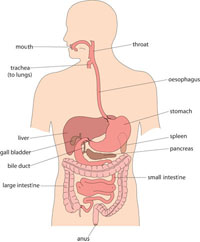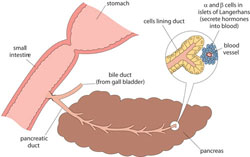2.2.2 The pancreas
The pancreas is a ‘leaf-shaped’ organ found deep inside the abdomen. The abdomen is the part of the body between the chest and pelvis. The abdomen contains such organs as the stomach, liver, spleen, pancreas, intestines and other structures (see Figure 2.2).

Alpha and beta are the first two letters in the Greek alphabet; they can also be written as the Greek symbols α and β.
The pancreas has a short connecting tube (the pancreatic duct, see Figure 2.3), which opens into the small intestine so that pancreatic juices can help with the process of digestion (as you learned in the Nutrition Module). Specialised cells in a part of the pancreas called the islets of Langerhans (after its discoverer) produce the hormones insulin and glucagon. The beta cells produce insulin and the alpha cells produce glucagon. When the body is healthy these two hormones help to keep the amount of glucose in the blood at the right level. If the pancreas is severely damaged or removed by operation, the production of insulin and glucagon will stop and diabetes will result.
2.2.1 Hormones in glucose regulation

